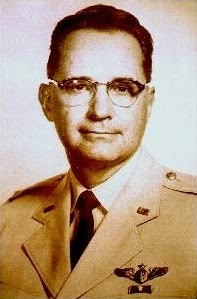 |
| Dr. John P. Stapp |
Just two months later, a less famous experiment was to bring a new level of understanding to human flight, advancing not only the study of aeronautics, but proving the miraculous resilience of the human body, and, at the same time, displaying an important lesson in leadership.
Captain John Paul Stapp, a medical doctor and member of the Army Air Force Aero Med Lab, was studying the effects of high altitude flight--critical to the future of aviation. Could men actually survive for any length of time in extremely high altitudes? The "bends"—which is basically decompression sickness, arising from dissolved gases coming out of solution into bubbles inside the body—was a frequent underwater diving hazard, and a condition brought on while flying in an unpressurised aircraft at high altitudes. Stapp's experiments on this phenomena led to the discovery that if a pilot breathed pure oxygen for thirty minutes prior to takeoff, the extremely painful symptoms could be avoided—symptoms otherwise temporarily relieved by "bending," or finding a more comfortable physical position.
"I'm going to be the test subject."—Dr. John Stapp
The bigger story for me is about Stapp himself. During the studies, he would offer himself as a willing human guinea pig for experiments. In the scientific quest to solve more problems regarding flight and its effect on humans, Stapp was eventually assigned to the Deceleration Project in March 1947. He arrived in California in April 1947 with the specific objective of studying G forces and the survivability of pilots, both during and after a mid-flight cockpit ejection.
 |
| One of Stapp's sleds, now at the Aerospace Museum, Alamogordo, NM |
constructed at Edwards AFB—then called Muroc—to test rockets in WWII. The track was designed to withstand 100 G of force, but it had a meager 50% safety factor. In December 1947, after eight months and 35 test runs with 185-pound crash-test-dummy named Oscar Eightball, Capt. Stapp felt his team had gained enough experience to attempt a manned run. The willing leader said of the test subject Oscar, "We're not going to use these. You can throw this away. I'm going to be the test subject."
 |
| Stapp during a test. |
Stapp was born in Brazil to a family of American missionaries. His early experiences on the mission field may have helped establish the leadership principles that were prevalent during his career, which I summarize here: Lead by example through personal sacrifice.
Stapp's leadership example is a great lesson for all who desire to step out in front of the pack. I would follow Stapp anywhere, but I probably wouldn't want to take a ride in "Gee Whiz" for all the money in the world!
